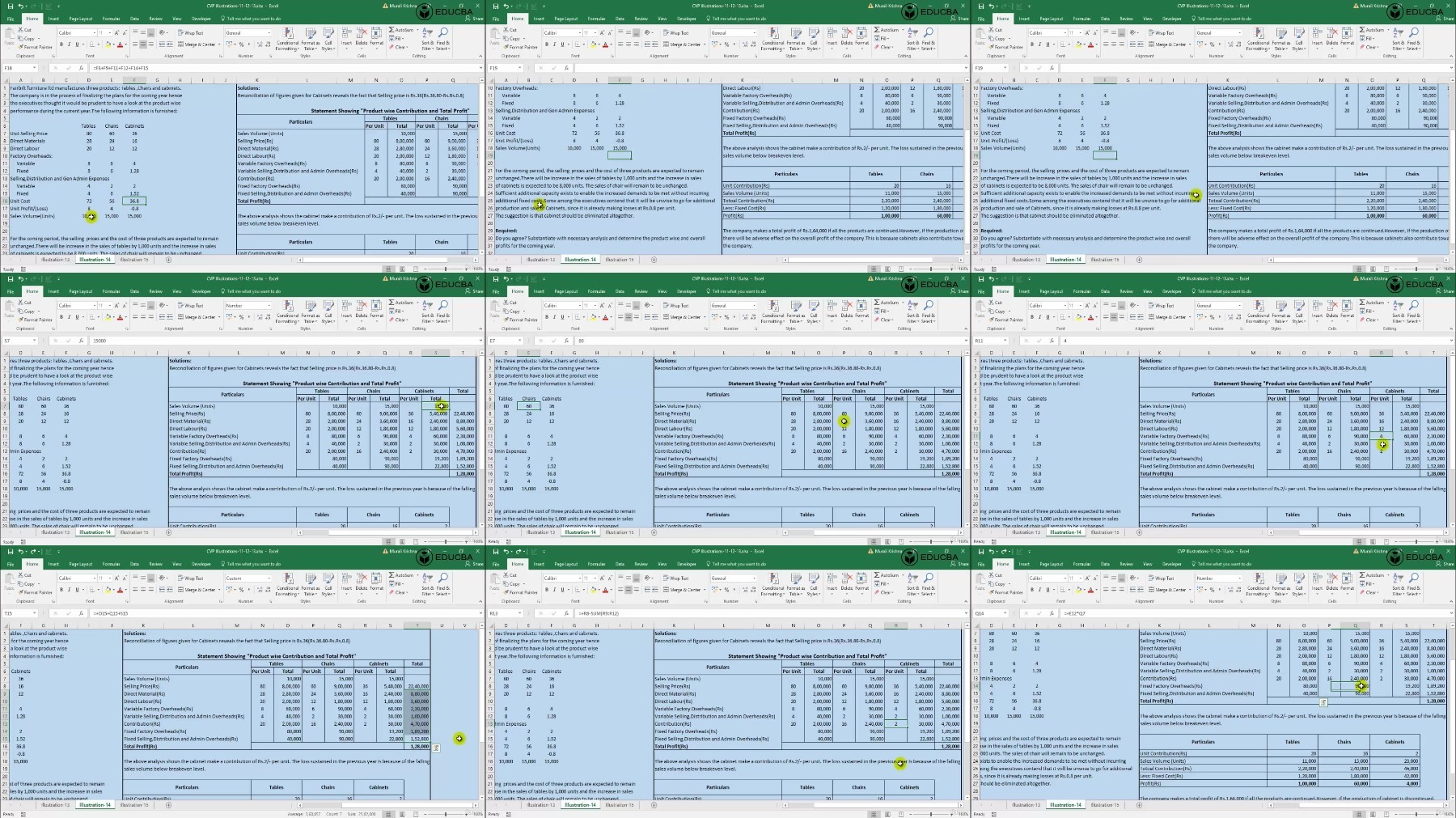Cost Volume Profit (Cvp) Analysis: Maximizing Biz Efficiency

Cost Volume Profit (Cvp) Analysis: Maximizing Biz Efficiency
Published 10/2024
MP4 | Video: h264, 1920x1080 | Audio: AAC, 44.1 KHz
Language: English | Size: 3.45 GB | Duration: 6h 46m
Unlock the secrets of profitability with our comprehensive course on Cost Volume Profit Analysis
What you'll learn
Fundamental Concepts of CVP Analysis: Gain a solid understanding of the basic principles of Cost Volume Profit analysis, including its components like costs.
Application of CVP in Business: Learn how to apply CVP analysis in real-world business scenarios, helping to inform strategic decisions regarding pricin.
Break-Even Analysis: Master the calculation and significance of the Break-Even Point (BEP), allowing students to determine the minimum sales required.
Cost Behavior Understanding: Explore how variable and fixed costs behave and their impact on overall profitability, aiding in effective budgeting.
Profitability Forecasting: Learn techniques to forecast profits based on different sales volumes and pricing strategies, providing insights into financials.
Sales Volume and Profit Relationship: Understand the intricate relationship between sales volume, contribution margin, and overall profit.
Pricing Strategies: Develop skills to calculate optimal selling prices based on cost structure and market conditions, enhancing competitive positioning.
Comprehensive Financial Statement Preparation: Acquire the ability to prepare detailed financial statements that reflect cost management, profit margins.
Practical Case Studies: Analyze real-life case studies to apply learned concepts and gain practical insights into the impact of CVP analysis.
Critical Thinking and Analytical Skills: Enhance critical thinking and analytical abilities by interpreting CVP data to make informed decisions.
Requirements
Basic Accounting Knowledge: A foundational understanding of accounting principles, including familiarity with financial statements, income statements, and balance sheets, is essential for grasping CVP concepts effectively.
Mathematical Proficiency: Students should have a basic level of comfort with arithmetic and algebra, as the course involves calculations related to costs, revenues, and profits.
Familiarity with Business Concepts: An introductory knowledge of general business concepts and terminology will help students understand how CVP analysis fits into broader business strategies.
Interest in Financial Analysis: A keen interest in financial analysis, decision-making, and business management will enhance the learning experience and outcomes.
Access to Course Materials: Students should have access to a computer or device with internet capabilities to engage with course materials, participate in discussions, and complete assignments.
Recommended Software Proficiency: While not mandatory, familiarity with spreadsheet software (e.g., Microsoft Excel or Google Sheets) is beneficial for performing calculations and creating financial models.
Description
In today's dynamic business environment, understanding the relationship between cost, volume, and profit is crucial for effective decision-making. This course, "Mastering Cost Volume Profit Analysis," provides an in-depth exploration of Cost Volume Profit (CVP) analysis, a fundamental tool for managers and accountants. Participants will gain essential skills to analyze financial data, assess the impact of variable and fixed costs, and determine optimal pricing strategies. Through a combination of theoretical concepts and practical examples, learners will be equipped to apply CVP analysis to real-world business scenarios, enhancing their ability to make informed financial decisions.Section 1: Introduction This section lays the groundwork for understanding Cost Volume Profit (CVP) analysis. In the first lecture, learners are introduced to the fundamental concepts of CVP, including its significance in business decision-making. The second lecture delves into the important concepts of CVP, such as contribution margin and its role in profitability. By the end of this section, students will grasp the basic principles that underlie CVP analysis.Section 2: Illustrations With Example Building on the foundational knowledge, this section provides practical illustrations of CVP analysis. Students will engage with various examples, highlighting how to apply CVP principles to real-world situations. The importance of variable costs is emphasized as learners analyze different scenarios, enhancing their understanding of how costs affect overall profitability. This hands-on approach ensures that students can relate theoretical concepts to practical applications.Section 3: CVP-Illustrations In this section, learners will explore break-even point analysis in-depth. Through detailed examples, students will understand how to calculate break-even points, analyze costs and profits, and interpret the implications for business operations. Additional CVP illustration examples will reinforce the concepts learned, allowing students to solidify their knowledge through practice. This section ensures that participants can effectively evaluate profitability through clear illustrations.Section 4: Profit and Sales Volume This section focuses on the intricate relationship between profit and sales volume. Students will learn to calculate optimal profits, machine hours, and savings, culminating in a comprehensive analysis of recommended product mixes. The lectures will guide learners through variable cost calculations, total contributions, and unit profits. By the end of this section, participants will be adept at analyzing financial statements and making data-driven decisions that enhance profitability.Section 5: Selling Price Understanding pricing strategies is critical in CVP analysis. This section covers the essentials of selling and distribution, with detailed calculations for determining selling prices. Participants will learn to assess the impact of price increases on profitability and evaluate fixed costs in relation to total sales. The exploration of alternative contribution methods will provide additional insights, equipping students with the tools to optimize pricing strategies for business success.Section 6: Prices per Component In the final section, students will focus on the component pricing strategy. This section involves calculating prices per unit and analyzing the costs associated with components. Learners will engage with various calculations to determine the quantity of components needed, assess variable costs incurred, and evaluate overall profit margins. By preparing detailed statements and balance sheets for produced components, students will gain practical experience in managing costs and pricing effectively.ConclusionThe "Mastering Cost Volume Profit Analysis" course provides an invaluable framework for understanding and applying CVP analysis in real-world business contexts. By the end of this course, participants will possess the knowledge and skills to analyze costs, set optimal selling prices, and make strategic decisions that drive profitability. Armed with practical examples and comprehensive insights, students will be prepared to excel in their financial roles and contribute to the success of their organizations. Join us on this journey to mastering financial analysis and decision-making!
Overview
Section 1: Introduction
Lecture 1 Introduction to Cost Volume Profit (CVP)
Lecture 2 Important Concept of CVP
Section 2: Illustrations With Example
Lecture 3 Illustrations
Lecture 4 Example of CVP
Lecture 5 Example of CVP Continues
Lecture 6 Variable Cost
Section 3: CVP-Illustrations
Lecture 7 Break Even Point Example
Lecture 8 Break Even Point Example Continues
Lecture 9 Cost and Profit Example
Lecture 10 More on Cost And Profit
Lecture 11 CVP Illustration Example
Lecture 12 CVP Illustration Example Continues
Section 4: Profit and Sales Volume
Lecture 13 Resulting Optimal Profit
Lecture 14 Calculation of Machine Hours
Lecture 15 Calculating Savings
Lecture 16 Statement for Recommended Mix
Lecture 17 Variable Cost Per Unit
Lecture 18 Total Contribution
Lecture 19 Variable of An Expenditure
Lecture 20 Total Fixed Cost
Lecture 21 Unit Profit and Sales Volume
Lecture 22 Trading Summary
Lecture 23 Contribution and Profit
Lecture 24 Sources of Procurement
Lecture 25 Recommended Requirement
Lecture 26 Analyzing Variable Cost
Lecture 27 Preparing the Statement
Lecture 28 Statement for Goods Sold
Lecture 29 Selling Price and Market Demand
Lecture 30 Statement for Products
Lecture 31 Profits from Sales
Section 5: Selling Price
Lecture 32 Selling and Distribution
Lecture 33 Calculating Selling Price
Lecture 34 Increased Selling Price
Lecture 35 Percentage in Production
Lecture 36 Estimating Fixed Cost
Lecture 37 Calculating Total Sales
Lecture 38 Alternative Contribution Method
Lecture 39 Calculating per Unit
Section 6: Prices per Component
Lecture 40 Prices per Component
Lecture 41 Calculation of Units
Lecture 42 Components for Purchase
Lecture 43 Variable Cost Incured
Lecture 44 Calculation of Quantity
Lecture 45 Calculating Existing Components
Lecture 46 Statement Showing Profit
Lecture 47 Balance Produced Components
Lecture 48 Calculation of Units Sold
Business Students: Undergraduates and graduates studying business administration, finance, accounting, or related fields looking to deepen their understanding of financial analysis.,Finance Professionals: Individuals working in finance, accounting, or management roles who want to improve their skills in analyzing costs, volume, and profit relationships to drive business performance.,Small Business Owners: Entrepreneurs and small business owners who need to understand their cost structures and pricing strategies to make informed decisions about profitability and growth.,Managers and Executives: Managers and executives responsible for strategic planning, budgeting, and performance analysis who want to leverage CVP analysis for better decision-making.,Analysts and Consultants: Financial analysts and business consultants seeking to apply CVP analysis to support clients in improving operational efficiency and financial performance.,Career Changers: Individuals looking to transition into finance or business roles who want to build foundational knowledge in cost volume profit analysis.

Fikper
https://fikper.com/Fhf12kpPpX/Cost.Volume.Profit.CVP.Analysis.Maximizing.Biz.Efficiency.part1.rar.html
https://fikper.com/rrHUboHVUh/Cost.Volume.Profit.CVP.Analysis.Maximizing.Biz.Efficiency.part2.rar.html
FileAxa
https://fileaxa.com/6gs9y76yk5wd/Cost.Volume.Profit.CVP.Analysis.Maximizing.Biz.Efficiency.part1.rar
https://fileaxa.com/20gc41eqs6tb/Cost.Volume.Profit.CVP.Analysis.Maximizing.Biz.Efficiency.part2.rar
RapidGator
https://rapidgator.net/file/3144229a25ad59a1a1a5d3b98e403af0/Cost.Volume.Profit.CVP.Analysis.Maximizing.Biz.Efficiency.part1.rar
https://rapidgator.net/file/d251b4ed0d2f56f54eb4b343d0929ade/Cost.Volume.Profit.CVP.Analysis.Maximizing.Biz.Efficiency.part2.rar
TurboBit
https://turbobit.net/3bu0srgquy0s/Cost.Volume.Profit.CVP.Analysis.Maximizing.Biz.Efficiency.part1.rar.html
https://turbobit.net/26akermdudno/Cost.Volume.Profit.CVP.Analysis.Maximizing.Biz.Efficiency.part2.rar.html
